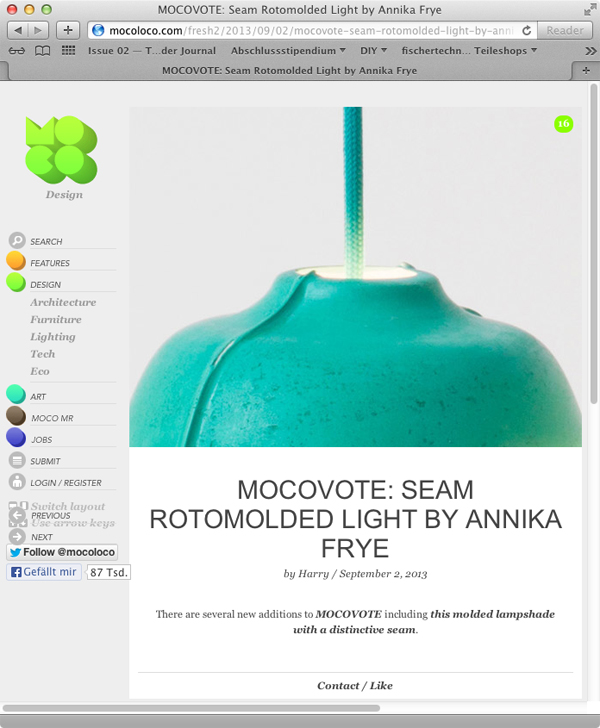CLAUDE is a rotomolded lamp that is produced individually in my atelier using a DIY-rotomolding machine. It is available in two sizes.


This video shows the process of making a lampshade in my atelier at HfG Offenbach. The video was filmed by Tania Ost.
CLAUDE is made in a DIY-rotational molding machine. It was originally a test – shape that I designed to experiment with my DIY- rotational molding machine. The lampshade is made from a polymer plaster. A mold is filled with the plaster and than rotated; due to the rotation the plaster sticks to all parts of the mold and a wall thickness emerges. The seam of the molding process is still visible in the product, so are the irregularities of casting process.
After some months of experimentation with different shapes and additives such as wood or textiles, I decided to use one test shape to improve the process. I tested all kinds of mixtures of polymer plaster with my test shape and I also did some color experiments. I started to write down everything I did, like laboratory workers do.

The outcome of my color and material experimentation is a simple lampshade: The molding process compromises three steps with different layers and different colors. The drops inside the lampshade refer to the movement of the machine. The lampshade comes in different colors: green, white and red. It has a smooth surface on the outside, it is sanded and covered with a protective layer of vaseline.

Because of the irregular material thickness, the lamp needs a special fixture that enables the user to adjust the lampshade. The fixture is made from sandblasted plexiglass. The special fixture also determines the form of the lampshade: a bigger hole is necessary at the top of the shade in order to adjust the lampshade, the light passes through. The fixture works as a diffusor.
THE PROCESS
This video shows the process of rotational molding in my atelier in Offenbach where I am producing the lampshades. The video was filmed by Tania Ost. The lampshade is made from a polymer plaster. The mold is filled with the plaster and than rotated; due to the rotation a wall thickness emerges while the material reacts inside the mold. Usually, this is an industrial process, but I transferred it to my atelier context. I changed the material (usually plastic) and the way the molds are made.

EXHIBITIONS

The CLAUDE lights in the MAK in Vienna, at the exhibition »Nomadic furniture 3.0. New Liberated Living?«.


The lights in Milan at »MOST« by Tom Dixon


IDEE
Diese Leuchte wird in einer selbstgebauten Rotationsgussapparatur produziert. Der industrielle Rotationsgussprozess
wird normalerweise bei der Produktion von Kunststofftonnen, Gartenmöbeln und sogar Schokoladenhasen eingesetzt. Dabei schwenkt man die Gussform in einer speziellen Apparatur, sodass sich der Kunstoff während des Aushärtens darin verteilt. Ich habe eine eigene Apparatur gebaut und verwende anstelle eines thermoplastischen Materials eine besondere Gipsmischung.
Weil die Gussform für den Leuchtenschirm aus tiefgezogenem Polysterol zwei Teile hat, entsteht eine umlaufende Naht, die auf das Gussverfahren verweist. Die Form ist zunächst vollständig und wird dann aufgeschnitten. Im Innern des Schirms werden die Unregelmäßigkeiten und Zufälle des Prozesses anhand von Tropfen sichtbar. Jede Leuchte ist einzigartig.

Da jeder Schirm anders ist, braucht es eine spezielle Halterung, um die Leuchte zu justieren. Dafür wird eine größere Öffnung für das Kabel notwendig: Etwas Licht dringt also immer auch nach oben durch diese Öffnung, während die Halterung zugleich wie ein Diffusor funktioniert.


PROZESS
Der Leuchtenschirm wird in drei Schichten gegossen, und an der Außenseite mit Öl versiegelt. Die Leuchte hat ein Textilkabel, das die gleiche Farbe hat wie der Schirm.
AUSSTELLUNGEN
Ausstellungen: Mailänder Designwoche 2013 (»MOST« im Museum für Wissenschaft und Technik), ausserdem im MAK Wien in der Ausstellung »NOMADIC FURNITURE 3.0
Neues befreites Wohnen?«, und »FRONT SALON« von DUTCH DESIGN YEAR im Beurs van Berlage in Amsterdam. Dieser Entwurf ist als Vorarbeit zu meinem Promotionsprojektes zur Improvisation im Design zu entstanden.



PRESS
This product was featured on mocoloco.com/vote

and on dezeen.


